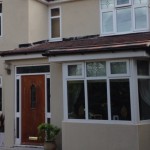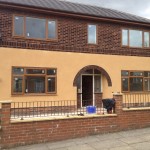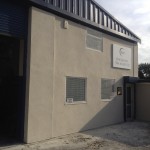With sales at a 50 year low, homeowners are deciding to stay put and pour any money saved on legal and removal fees into renovating and improving their properties.
While large construction projects are taking a hit from the drop in demand, homeowners are still spending money on improving their homes, especially those who had plans to move in the next year or so.
It makes sense to use this time of static housing market to make your home more attractive for a time when things get moving again – you’ll also be doing your bit to help keep the economy going. But what to spend the money on? A swanky new bathroom with steam and wet room features or a new energy efficient boiler?
While the bathroom might sound sexier, the boiler may well end up being the more sensible purchase.
According to new research published by the Energy Saving Trust, carbon appeal may soon replace kerb appeal when it comes to attracting buyers to your home. The study, which surveyed 2,090 homeowners, revealed that 53 per cent of householders said they would be willing to pay extra – up to £3,350 extra – for a home with greener features. Furthermore, over three quarters – 78 per cent – of those surveyed agreed that having a ‘poor’ rating on their Energy Performance Certificate, now required on any home being sold, could lead to buyers haggling down on the asking price.
With the huge rise in energy bills over the past 24 months, investing in energy saving improvements could not only help you sell your home more easily, but will in the short term help reduce your gas and electricity bills this winter.
Philip Sellwood, chief executive of the Energy Saving Trust says, “In the current economic climate, it makes sense to ensure that the running costs of the home you are living in or buying are as low as possible as well as helping to cut down on your carbon dioxide emissions.”
Energy efficiency scores and solutions
What are the most cost effective ways of making your home more energy efficient? When you come to sell your home, a Domestic Energy Assessor will inspect your home before preparing your Energy Performance Certificate. Your home will be graded A – G, where A is the most efficient, with a possible maximum score of 100, and G is the least efficient.
The current average score for existing homes is a low D or high E rating and a score of 46. There are a simple range of measures you can take to boost your home into a C rating, and stand out from the D to E crowd. Don’t forget, if purchasers are looking at similar homes in similar locations but your home has a C rating and others have an E rating, it could be the factor that clinches the deal.
The main areas a DEA will look at for compiling the EPC are:
- Walls and wall insulation: Are cavity walls filled? Do solid walls have extra internal or external insulation on them?
- Roofs: Is the roof flat or pitched and is there at least 270mm of insulation in the loft?
- Windows: Are windows, where the house is not subject to listing requirements, double glazed?
- Heating: Is the boiler old or new? Do radiators have thermostatic radiator valves?
- Hot water: How is water heated? What is the hot water cylinder insulation?
- Secondary heating: Does the home have any other heating sources, such as fireplace or wood burner?
- Lighting: What proportion of light bulbs are energy efficient?
Wall insulation
There are two main types of wall in British houses – solid walls or cavity walls. Most houses built since about 1925 were built with cavity walls: two skins of brick with a void between them. This is more insulating than solid wall, but the insulating properties are only really improved when the cavity is filled with material such as rockwool or spun glass fibres. Filling the cavity is a relatively simple and cheap process: a registered installer drills small holes in the external brickwork, then literally hoses the insulation into the cavity. The holes are then filled.
Grants are available either through the Energy Saving Trust or your gas provider, but your installer should apply for them on your behalf. This means that an average cost of around £500 for a detached house should cost around £250 – £300. Your installer will provide you with a 25 year guarantee for the work, which you must keep safe to show the DEA.
But you will feel benefits immediately: savings of around £120 – £150, sometimes more, are common as uninsulated walls lose around 33 per cent of a home’s heat. Make sure you use an installer covered by the Cavity Insulation Guarantee system.
Solid walls, found in older homes, are harder and more expensive to insulate. But the savings are much higher and insulating solid walls could boost your rating from ‘poor’ to ‘good’ with one single measure.
There are two ways of improving insulation in solid walls, either internal, or external. Internal insulation involves the installation of insulation-backed plasterboard, reducing room dimensions slightly. If you have large rooms and can afford to lose a little space, then a more attractive feature would be to put in wooden panelling, available in a range of styles from the beach hut chic tongue and groove style to the country house style large square panels with beading. You should put insulation such as Kingspan’s phenolic foam panels between the wood panelling and the wall.
For external insulation, external wallboards which come either as solid foam panels or even polystyrene panels, which are then covered in render can be fitted. These measures will cost around £40 – £45 per sq m but could save you around £400 a year in heating costs and will significantly boost your home’s EPC rating. For more information, visit the National Insulation Association website.
You may think that since you topped up your roof insulation 10 years ago, you’re alright. However the recommended thickness of insulation has been increasing over the years and where 50mm was considered acceptable 10 years ago, anything less than 270mm will lose you points on your EPC. Again this is a relatively cheap (£180 approx for topping up, £250-£500 from scratch) way of making your home cosier and scoring EPC points as 25 per cent of a home’s heat escapes through a badly insulated roof. Find an installer from the National Insulation Association website.
Window glazing
Single-paned windows will score badly in your EPC and nowadays even in houses in conservation areas or listed buildings, it is easier to get permission to install double glazing. However, while good quality double glazing will earn you EPC points, cheap PVCu double glazing which does not complement your home’s look will lose it value. So it’s worth spending a little bit more, especially if you live in a period home.
Wooden double glazed units are also better for the environment if the wood comes from Forestry Stewardship Council sources. A gap of about 1cm between the front and back panes will give you optimum insulation. For wood-framed windows in period buildings, contact the Box Sash Window Company. For windows in less traditional houses, check for frame material and energy efficiency at the British Federation Ratings Council website. Cost varies enormously, depending on window size, type and materials used, from £150 for a small standard window to over £1,000 a unit for large period sash windows.
Energy efficient boilers
Old and inefficient boilers score particularly badly on EPCs and boilers over 15 years old will normally be rated as poor. Any new boiler you install today must by law be one of the new condensing boilers – they recover more heat from the flue than older models and could save you up to £240 per year. They are more expensive than insulation – expect to pay around £1500 for one of the top of the range models such as the Vaillant EcoTec. But if you expect to stay in your home for the next year or two, you could recoup a third of the cost before you move. For more information, visit the Vaillaint website.
To accompany your new boiler, fit thermostatic radiator valves to help regulate the temperature of your rooms. They are relatively cheap (about £7 per unit) and as well as helping your EPC score, could save you money by keeping bedrooms and underused rooms at a lower temperature.
Other ways to make your home greener
Other minor changes you can make, with maximum results, are to replace all your old tungsten bulbs with energy efficient ones, as your DEA will count all tungsten bulbs against you. If you don’t like the cool look of light from fluorescent bulbs, warm coloured lampshades in pink, cream or yellow will help maintain a warmer look in the room.
Replace your old hot water cylinder jacket with a super-thick (75mm plus) one.
Finally, if you have a fireplace, install a super efficient wood burning stove. Not only do secondary sources of heating score on EPCs, but this eco friendly (wood burning is carbon neutral) feature will help you stave off switching on the heating for a few extra weeks and a merrily crackling fire in a living room will attract any prospective purchaser. Stoves Online has a good range of eco friendly wood burners.
Please Note: Some information contained herein may have changed since it was first published. We strongly advise you to seek current legal and/or financial advice from a qualified professional.
This Article was sourced from PrimeLocation.com









